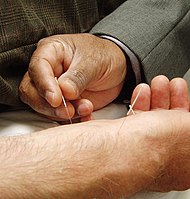
Photo from wikipedia
Objective. Previous studies demonstrated the possibility to fabricate stereo-electroencephalography probes with high channel count and great design freedom, which incorporate macro-electrodes as well as micro-electrodes offering potential benefits for the… Click to show full abstract
Objective. Previous studies demonstrated the possibility to fabricate stereo-electroencephalography probes with high channel count and great design freedom, which incorporate macro-electrodes as well as micro-electrodes offering potential benefits for the pre-surgical evaluation of drug resistant epileptic patients. These new polyimide probes allowed to record local field potentials, multi- and single-unit activity (SUA) in the macaque monkey as early as 1 h after implantation, and yielded stable SUA for up to 26 d after implantation. The findings opened new perspectives for investigating mechanisms underlying focal epilepsy and its treatment, but before moving to possible human application, safety data are needed. In the present study we evaluate the tissue response of this new neural interface by assessing post-mortem the reaction of brain tissue along and around the probe implantation site. Approach. Three probes were implanted, independently, in the brain of one monkey (Macaca mulatta) at different times. We used specific immunostaining methods for visualizing neuronal cells and astrocytes, for measuring the extent of damage caused by the probe and for relating it with the implantation time. Main results. The size of the region where neurons cannot be detected did not exceed the size of the probe, indicating that a complete loss of neuronal cells is only present where the probe was physically positioned in the brain. Furthermore, around the probe shank, we observed a slightly reduced number of neurons within a radius of 50 µm and a modest increase in the number of astrocytes within 100 µm. Significance. In the light of previous electrophysiological findings, the present data suggest the potential usefulness and safety of this probe for human applications.
Journal Title: Journal of Neural Engineering
Year Published: 2021
Link to full text (if available)
Share on Social Media: Sign Up to like & get
recommendations!